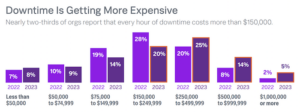
Observability Drives Rapid Resolution of Unplanned Downtime, Splunk Report Shows

(JOKE_PHATRAPONG/Shutterstock)
Splunk has just released its State of Observability 2023 report that found observability leaders are four times as likely to resolve instances of unplanned downtime in minutes, versus hours or days.
Reducing outages is one main use case driving observability, or the ability to understand a system’s internal state and performance by examining outputs such as logs, metrics, and traces. Splunk says observability has matured beyond its early adopter position to become foundational to modern enterprises due to the rising complexity of IT environments. Downtime is getting more expensive, as nearly two-thirds of organizations report that every hour of downtime costs more than $150,000.
Splunk’s report defines observability leaders as organizations with at least two years of experience with observability, and the company lists five other factors in which leaders tend to rank highly: the ability to correlate data across all observability tools, the adoption of AI/ML technology within their observability toolset, skills specialization in observability, the ability to cover both cloud-native and traditional application architectures and the adoption of AIOps.
The report’s key findings include the fact that leaders experience 33% fewer outages per year than observability beginners, with leaders reporting two outages compared to six outages disclosed by beginners. Finding and fixing problems faster is driving ROI according to 81% of those surveyed, and 86% of leaders report that ROI on their observability tools has exceeded their expectations. Reliability goals are also easily met with observability tools, as 89% of leaders report total confidence in their ability to meet availability and performance requirements for their applications, which is 3.9x higher than beginners.
Resilience has been an essential theme in business underscored by the pandemic, and the report highlighted how 100% of observability leaders collaborate with other line-of-business leaders (security, finance, marketing, operations, etc.) on resilience strategies, investments, and identification of critical business systems to protect. Additionally, 97% of leaders cite having a formal approach to resilience, and 81% have instituted that strategy across the organization to protect critical systems. Splunk says this organization-wide resiliency approach was only 8% for beginners, illuminating a key area of improvement for the future.
Of the different types of companies leading in observability maturity, communications and media companies are in the lead with 13% counted as leaders. Manufacturing and financial services followed with 8% categorized as leaders. The report uncovered an opportunity for growth in the public sector, as 4% were counted as leaders up from 0% in 2022. Interestingly, the report indicated that organizations in financial services tend to be less mature in observability with only 8% categorized as leaders, while 43% are beginners.
Some organizations have reported unifying their security monitoring and observability tools for reasons such as more granular and precise threat detection (59%), a more comprehensive approach to uncovering security vulnerabilities (55%), and the ability to act on security issues faster (51%).
The State of Observability 2023 annual global research report is a collaborative effort between Splunk and Enterprise Strategy Group with a global survey conducted from early December 2022 to mid-January 2023. The third annual report surveyed 1,750 observability practitioners, managers, and experts from organizations with 500 or more employees.
 “With the rising complexity of today’s technology environments and the direct connection between reducing disruptions and optimal customer experiences, observability is fundamental to the successful operations of modern businesses,” said Spiros Xanthos, SVP and general manager for the observability business at Splunk. “Observability enables businesses to keep their software and infrastructure reliable, systems secure and customers happy, making it a critical component to any organization’s resilience strategy.”
“With the rising complexity of today’s technology environments and the direct connection between reducing disruptions and optimal customer experiences, observability is fundamental to the successful operations of modern businesses,” said Spiros Xanthos, SVP and general manager for the observability business at Splunk. “Observability enables businesses to keep their software and infrastructure reliable, systems secure and customers happy, making it a critical component to any organization’s resilience strategy.”
Access the full report here and read a blog post from Xanthos discussing the report’s findings here.
Related Items:
Observability Primed for a Breakout 2023: Prediction
Data-savvy Organizations Are 9.5% More Profitable: Splunk
OpenTelemetry Gains Momentum as Observability Standard





























